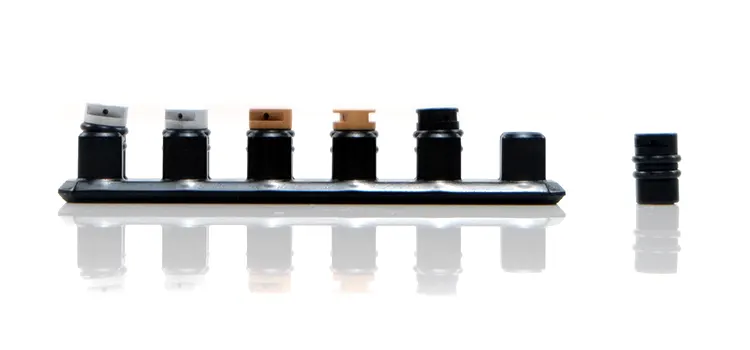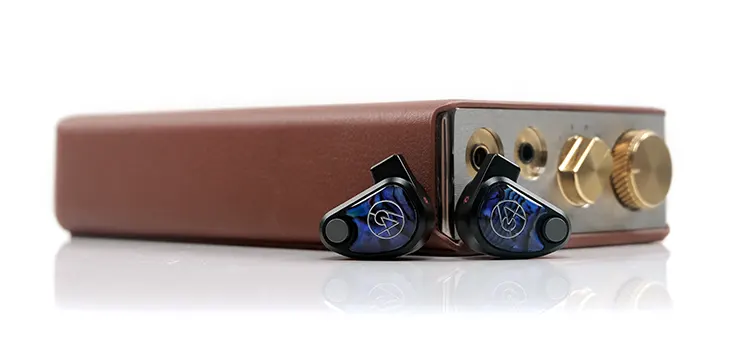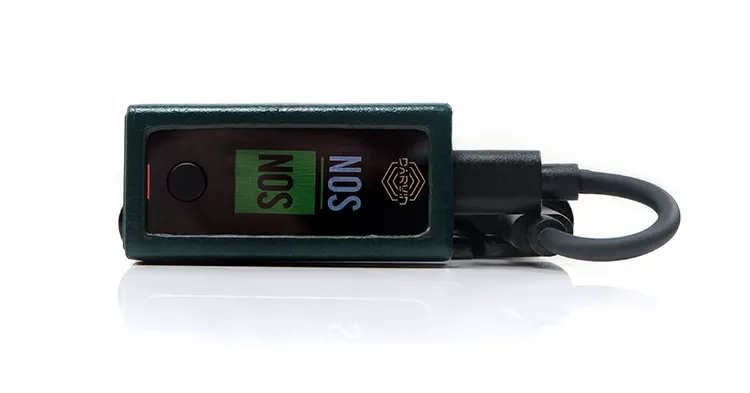Sound Impressions
The following sound impressions of the Volür were compiled using the iBasso DX320 MAX Ti and the Luxury & Precision P6 Pro as my main sources. The core descriptions were done using the stock m15 apex module, the stock Premium cables, and SpinFit tips.
Summary
The 64 Audio Volür takes the Nio trademark beefy and smooth sound signature up by quite a few notches. You get a tighter and more dynamic bass response, a more life-like and resolving midrange, and a more engaging treble performance.
It is still a very smooth and flowing tuning, so you will not find any of the airy treble ‘showmanship’ from the Trio nor is it quite as open and revealing in the mid/highs as the high-end U18s. What it does have is power, wonderful power, and a very natural midrange tone with excellent vocal imaging.
What you might find is the bass shelf from the Nio has been adjusted somewhat downwards. Not by a huge amount, but it is noticeable in terms of a reduced bloom through the mid-bass that reduces the amount of warmth relative to the Nio.
In turn, I find the Volür True Isobaric bass response to be more incisive and dynamic than the single driver inside the Nio. When it hits, it’s fast, firm, and very deep sounding but also one that does not overwhelm the mids allowing it to create a more interesting and complex presentation.
I would go as far as to say the Volür also has a more impressive sub-bass response compared to the Trio and certainly a more powerful and weightier delivery than the U18s.
Also, if you felt the Nio was too dark or relaxed in its mids and highs imaging then the Volür’s new tia waveguide formula addresses that nicely without it taking over the entire range.
You get a welcome layer of subtle contrast throughout the Volür timbre that helps shape and define the notes sounding more incisive and clear as a result. Vocal clarity is also excellent relative to the more relaxed and softer Nio tuning.
Frequency Response
Every filter bar the mX is going to give you an elevated bass response from the Volür if we use the Harman Target as our benchmark for its observable frequency response.
Overall, the bass shelf is slightly reduced compared to the Nio over the 100-200hz range and perhaps on par or just slightly below the Nio sub-50Hz.
That only tells half the story though because the True Isobaric setup inside the Volür does sound a lot tighter. Some of this tightness is due to the reduction in mid-bass bloom but the rest is just a superior technical performance in terms of speed and dynamic range.
Up to 1k, the Volür has a similar gentle dip to the Nio into the lower-mids but it does not carry as much warmth. Still relatively smooth for me though and not a lean sound signature but it does improve on the bass-to-mids separation and one factor in the improved Volür midrange space.
64 Audio has also given the Volür 1-3k range a more pronounced lift over the Nio. Vocals are more distinct and more forward-sounding but they are also better defined with the increased treble influence. They have a generally cleaner tone and more space behind them.
From 5-10k, the Volür is energetic but not over-amplified. You also get a nice upper-treble lift around the 10k mark. Compared to the Trio and at times the U18s the highs are more controlled and not quite as exuberant. However, it is vastly more energetic with better extension than the Nio highs which are darker in comparison.
Timbre
I would give the Volür timbre a high-level ‘natural sound’ descriptor but contextually it is more accurate than the darker Nio, and smoother and fleshier sounding compared to the Trio, particularly through the mids and highs.
You still get the same depth and extension from the Volür lows but the speed and dynamic range is perhaps the most impressive yet from a 64 Audio monitor.
It is not just a weighty fundamental but one with a little more of an upper harmonic bias in it creating a superior level of definition and clarity compared to both the Trio and Nio’s single dynamic driver’s performance.
You might not notice it if a track starts off with midrange or treble energy, particularly areas where the Trio and U18s have a lot of energy. However, once that low-end chimes in the power destroys the U18s equivalent and feels more concussive at its peak than the Trio.
That better blend of harmonics is also present in the mids and vocals where the Nio can sound relatively veiled in comparison.
The Volür mids have much-improved clarity but still retain a relatively smooth and flowing tone using the SpinFit tips. You can soften it a little further with the foam tips but I find they tend to damp down on the clarity a little in comparison.
You can pick up on the improved treble energy through the upper mids with cymbal crashes not quite as muted compared to the Nio. At times though light touch spatial cues can sound somewhat ethereal in tone compared to the more forceful portrayal of background spatial cues from the U18s.
Staging & Dynamics
If you are coming from the Nio, the first thing you will notice is just how much more revealing and complex sounding the Volür imaging is, particularly through the mids and highs which have improved separation and headroom.
That might seem surprising to lead off with considering the Volür calling card is the True Isobaric dual dynamic driver configuration. However, for me, this is not about more bass volume but rather a tighter more impactful, and faster bass response. The lift in dynamic range is palatable from these new drivers.
The depth is excellent, and it was excellent also on the Nio but the bass to mids separation with less of the bloom makes the difference here creating an improved sense of space and shifting the weight down more towards a sub-bass bias.
The Volür is not as wide as the Trio or the U18s nor as tall as the Trio but it’s definitely more extended and holographic sounding compared to the Nio.
Despite the superior height and width of the Trio, I find the Volür mids and highs to have a more balanced tuning throughout. The Trio is a bit of a rollercoaster and how much you go for it depends on the tip choice and your personal preferences.
Vocals are noticeably more vibrant and slightly further forward compared to the Nio though I still find this a relatively relaxed midrange tuning and not one that shoots way over the usual benchmark Target curves.
A lot of that vibrancy also comes from an improved treble response compared to the Nio, adding more definition to notes and at times a slightly ethereal tone from airy spatial cues.
apex Filters
Personally, I do not think the mX filter should be there unless you are a complete mids and treble head. The reduction in the bass weight and power is very noticeable and kills a lot of the magic of the Volür leaving a very flat and uninteresting performance.
I suspect most people looking for a balanced and spacious tuning will rotate between the m12 and m15 performances. The m12 will reduce the bass weight a little relative to the m15 creating a slightly airier tone. Out of the two, I preferred the m15’s slightly more saturated sound and weightier low-end.
The m20 will deepen the power of the bass over the other filters and it’s one I would turn to for EDM and R’n’B and some thrash metal also. It still keeps potential bloom nicely in check but if you are after the full weight of the Volür but with slightly less mids and highs influence then it’s going to be a logical choice.
Synergy
Efficiency
The Volür is rated at 6.2Ω impedance with an SPL of 103 dB/mW @1kHz @1mW making it slightly less efficient on paper than the Nio but with more or less the same load at 6Ω impedance and 105dB @1kHz 1mW.
To be honest, the Volür is pretty consistent with the rest of the 64 Audio universal IEM line-up with perhaps only the U18s creating a small gap in terms of audible loudness. I include the Trio, U18s, and the Nio in that statement.
The U18s is rated at 105 dB SPL but I actually found I needed to push up its volume to correctly match my subjective listening level of the Volür. It may well be the leaner bass on the U18s created a psychoacoustic effect of looking for more juice to satisfy.
All DAPs and dongles tested drove the Volür easily enough though for dongles I would advise going to a high gain mode. It is not a super sensitive IEM by any means and I do tend to find high gain in dongles more useable, especially if you are using an SE cable with the Volür.
You should be presented with no background hiss or noise floor issues with the Volür using most modern DAPs and dongles.
DAP Pairings
The Volür is a very flexible monitor when it comes to DAP pairings. I tested 4 DAPs including the Mojo 2 as a 5th portable source and in truth, I never once heard the sound signature come undone in terms of imbalance, too much sibilance, or a shallow bass performance.
Each DAP brought an element of its own sound signature into the Volür presentation which will give you some subtle emphasis to each pairing.
iBasso DX320 MAX Ti & Mojo 2
For example, the iBasso DX320 MAX Ti and the Cayin N8ii both offer the most height and sparkle with the DX320 MAX Ti a little more articulate and precise and perhaps the most dynamic in terms of bass speed and impact.
The DX320 MAX Ti also has the most width and headroom of the DAPs tested though I have to admit the Mojo 2 was on par for holographic and precise imaging and did deliver a bit more sub-bass impact as well.
Cayin N8ii
The N8ii brings its characteristic tube tonal character to the notes so a little bit more decay and a slightly softer attack but more than any DAP it produces the most vivid and sweetest vocal delivery out of all of the DAPs tested.
If you want vocal presence to the fore combined with the P+ mode for a smooth and punch bass then the N8ii is a good choice.
Luxury & Precision P6 Pro
I you want a more analog tone to the Volür both the N7 and the P6 Pro are good choices. The P6 Pro and Volür pairing is more intimate than the N7 which casts a wider more spacious soundstage but the richer bass and vocal notes of the R-2R P6 Pro are very addictive. Of the DAPs tested it fleshed out the best overall midrange though vocals lacked the sparkle of the N8ii.
Cayin N7
The N7 vocals are more neutral in their imaging and lack the energy of the N8ii through the mids also. The Volür bass is thicker and denser compared to the DX320 MAX Ti but lacks the dynamics and punch of both it and the Mojo 2.
Dongle Pairings
I went through three dongles, the Cayin RU7 and RU6 as well as the HiBy FC6.
By far the most complete experience with the Volür was the RU7. It offered the most holographic soundstage, the best technical performer in terms of detail, and also the most refined tonal balance.
The RU6 will switch up the emphasis to the vocal presence a bit more. It also produces some nice sparkle in the highs but it also softens the low-end of the Volür in exchange. It still hits well but it’s not as dense and for me, losing the prowess of the Volür lows is not where I want to be with this monitor.
On the other hand, the FC6 was like a guilty pleasure. It’s not as holographic as the RU7 or as refined but its bass texture and density were additive. If you want the Volür at its weightiest then the FC6 is the best of the three for delivering that.





